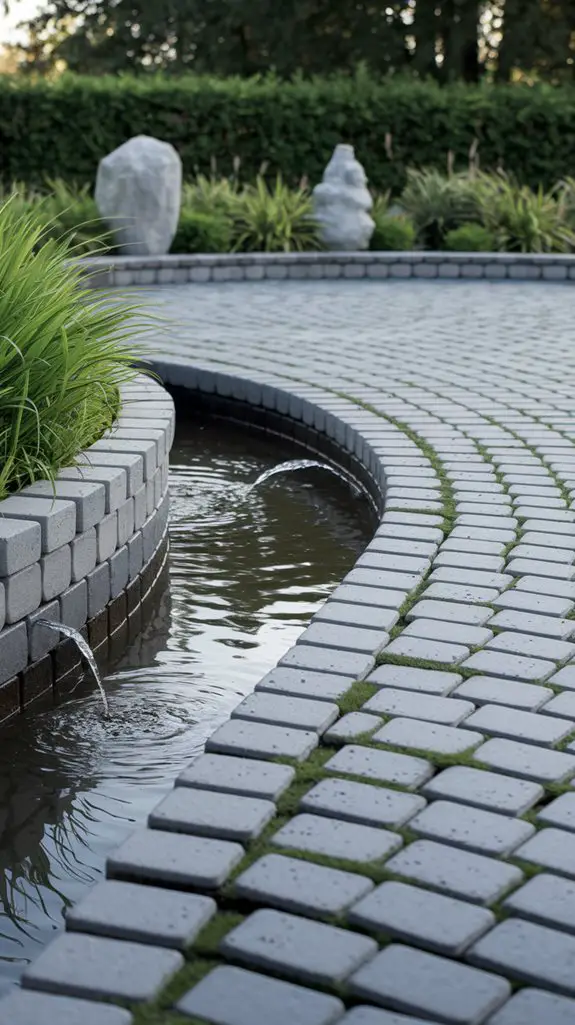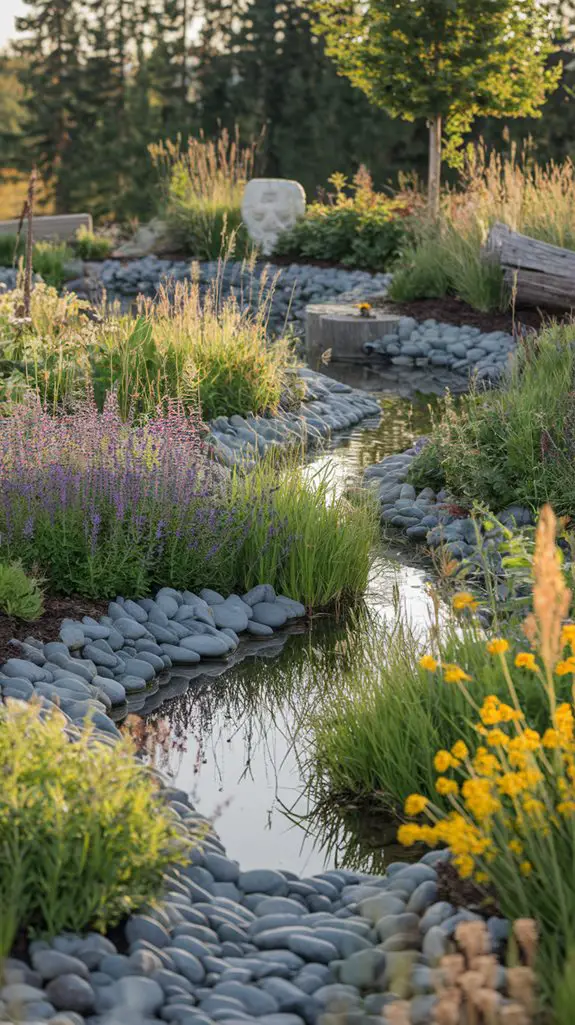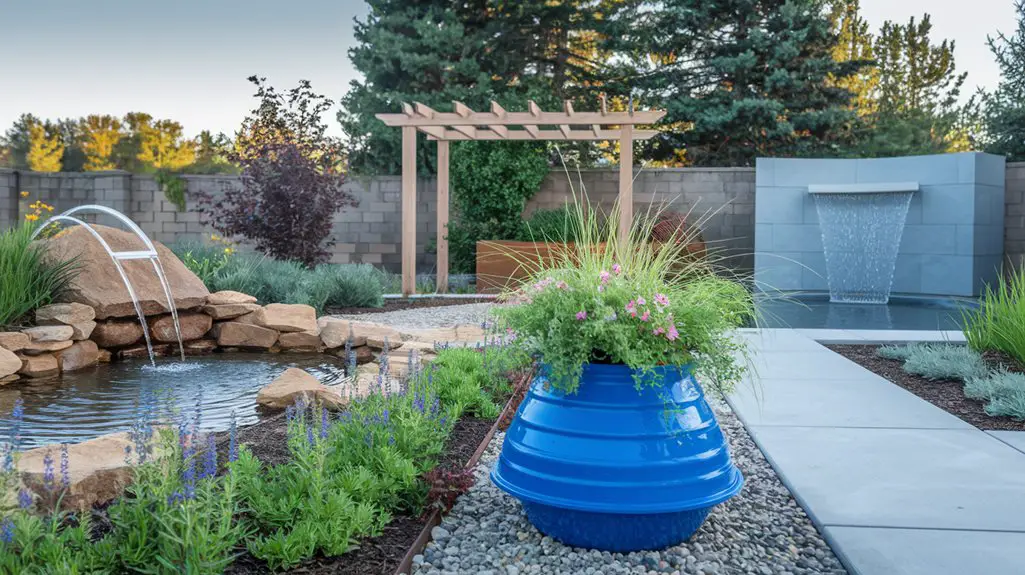Most homeowners collect only 2% of available rainwater on their property, missing a significant opportunity for sustainable landscaping. You’re fundamentally watching a free resource wash away with every rainfall, while simultaneously paying to irrigate those same outdoor spaces. By integrating rainwater harvesting into your landscape design, you’ll not only reduce water bills but also create resilient outdoor features that withstand drought conditions and enhance your property’s aesthetic value. The techniques that follow will transform how you approach water management.
Decorative Rain Barrels and Collection Systems
Elegance and functionality merge seamlessly in decorative rain barrels and collection systems, transforming practical water conservation into an aesthetic garden feature.
You’ll find options ranging from hand-painted ceramic urns to copper-finished steel containers that complement various landscape designs.
For ideal placement, position your decorative barrel beneath downspouts, installing a diverter to channel water efficiently.
Many modern systems incorporate fine-mesh screens that filter debris while preventing mosquito breeding.
Consider linked barrels for expanded capacity—a 50-gallon primary unit can connect to secondary containers through overflow ports.
Select UV-resistant materials for longevity in direct sunlight.
Ceramic and concrete vessels offer natural cooling properties that help maintain water quality, while integrated spigots at varied heights allow gravity-fed irrigation for different garden zones. Additionally, implementing effective rainwater filtration solutions can enhance the quality of collected water for your garden.
Permeable Patio Surfaces With Underground Storage

Permeable patio surfaces with underground storage represent an innovative dual-purpose solution for rainwater management.
These systems feature specialized pavers or porous materials that allow precipitation to filter through rather than run off, directing water to a collection chamber beneath your patio.
You’ll find several options including permeable concrete, porous pavers, or gravel systems installed over a structural reservoir.
This subsurface chamber, typically composed of crushed stone and geotextile fabric, stores water for gradual release into surrounding soil or connects to irrigation systems via pumps.
The design delivers multiple benefits: reduced runoff, groundwater recharge, flood prevention, and a water supply for gardens. Additionally, implementing eco-friendly rainwater harvesting practices can enhance the sustainability of your landscape.
When planning your installation, consider soil type, anticipated rainfall volume, and desired storage capacity to create a system that’s both functional and aesthetically pleasing.
Rain Gardens for Natural Water Filtration

When strategically positioned in low-lying areas of your landscape, rain gardens serve as natural water filtration systems that capture runoff from roofs, driveways, and other impervious surfaces.
These engineered depressions filled with deep-rooted native plants, gravel, and specialized soils can reduce water pollution by up to 30% while recharging groundwater supplies.
For ideal rain garden design, consider:
- Size your garden to approximately 20-30% of the drainage area it serves
- Include layered filtration media—coarse gravel at bottom, sand in middle, amended topsoil above
- Select native plants with varying root depths to maximize absorption and evapotranspiration
You’ll achieve maximum filtration efficiency by locating your rain garden at least 10 feet from building foundations and avoiding utility lines.
The resulting microhabitat will manage stormwater while supporting beneficial pollinators.
Living Water Walls With Integrated Collection
Living water walls represent one of the most innovative approaches to vertical rainwater harvesting, combining aesthetic appeal with practical water collection functionality.
These systems feature vertical panels with integrated plants and collection channels that capture rainfall as it cascades down the surface.
You’ll need to select drought-tolerant plants suitable for vertical growth like sedums, ferns, and certain grasses.
The modular panels typically incorporate reservoirs that store water at the base, often with submersible pumps that recirculate water during dry periods.
For peak performance, install a first-flush diverter to guarantee contaminants from the initial rainfall don’t enter your system.
The integrated gutters and collection tubes can connect to storage tanks or be directed to garden beds, creating a self-sustaining ecosystem that beautifies your space while maximizing water efficiency. Additionally, incorporating rainwater systems can significantly enhance sustainability in your backyard design.
Rainwater-Fed Pond and Water Feature Designs
Transforming your outdoor space with rainwater-fed ponds and water features creates sustainable focal points that enhance biodiversity while conserving municipal water supplies. These systems channel collected rainwater into aesthetically pleasing landscape elements that serve dual purposes. When designing your rainwater-fed water feature, consider:
- Filtration stages – Incorporate gravel beds, biofilters, and aquatic plants to naturally purify water before it enters the main feature.
- Overflow management – Design swales and secondary catchment areas to handle excess water during heavy rainfall events.
- Circulation systems – Install solar-powered pumps to maintain water movement, preventing stagnation and mosquito breeding.
The ideal pond design incorporates varying depths with shallow plant shelves and deeper zones for temperature stability. Including submerged aerators helps maintain oxygen levels while reducing maintenance requirements. Additionally, using rainwater collection barrels can maximize the efficiency of your water feature by ensuring a consistent supply of water during dry periods.
Conclusion
By integrating these five rainwater harvesting solutions, you’re not just enhancing your outdoor aesthetics—you’re embracing sustainable design principles that work with nature rather than against it. Isn’t it remarkable how functional water management can simultaneously create stunning focal points? Your landscape becomes a showcase of environmental stewardship while reducing water bills and runoff. The perfect fusion of innovative design and ecological responsibility awaits in your backyard.




